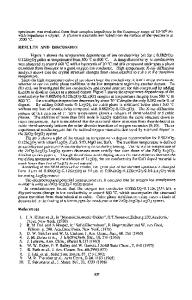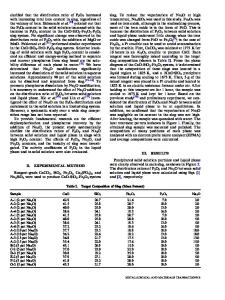Phase relations in the system Na 2 ZnP 2 O 7 -Zn 2 P 2 O 7
- PDF / 509,115 Bytes
- 7 Pages / 576 x 792 pts Page_size
- 43 Downloads / 326 Views
Data on phase relations in the system Na 2 ZnP 2 O7-Zn2P2O 7 reported in the literature are scarce and contradictory. The system was first studied by Berul and Voskresenskaya fRuss. J. Inorg. Mater. (English transl.) 4 (12), 2129 (1968)], who established the existence of a congruently melting intermediate compound, Na 8 Zn 6 (P 2 O 7 ) 5 . In the paper by Majling et al. [Chem. Zvesti. 28 (3), 294 (1974)], the system Na2ZnP2O7-Zn2P2O7 is considered to be eutectic. The subsolidus phase relations are represented by a mixture of two phases, terminal members of the system. The existence of the above-mentioned compound was not confirmed for this system. In the present work we studied the phase relations in the system Na2ZnP2O7-Zn2P2O7 on samples obtained by solid-state synthesis and glass crystallization. The sequence of crystallization of phases was investigated, and the equilibrium and metastable phase diagrams were constructed for the system.
I. EXPERIMENTAL TECHNIQUES Initial components used in sample syntheses were Na 4 P 2 O 7 and Zn2P2O7. Sodium pyrophosphate, Na 4 P 2 O 7 , was obtained by dehydration of the reactant grade Na 4 P 2 O 7 • xH 2 O (where x = 8 to 10) at 500 °C for 3 h. Zinc pyrophosphate, Zn2P2O7, was synthesized from chemically pure ZnO and high-purity NH4H2PO4 by solid-state sintering in the temperature range 300-900 °C with intermediate grinding between series annealing. The initial components Na4P2O7 and Zn 2 P 2 O 7 taken in appropriate ratios were mixed in alcohol, dried, pressed into tablets, and fired at 600 °C for 48 h with intermediate grindings to obtain completely homogeneous samples to be used for the study of equilibrium phase relations in the join of the system and for the synthesis of glasses of desired compositions. Glass samples were prepared by melting for 15 min in Pt crucibles at temperatures exceeding by 100 °C the melting temperature, with subsequent air quenching of the samples on steel plate. The composition of the samples obtained was systematically controlled by chemical analysis for sodium, zinc, and phosphorus contents. The phase relations in the system (equilibrium and metastable) were studied by dynamic (high-temperature x-ray diffraction and DTA) and statistical (annealing and quenching) methods. To identify the annealed samples the crystal-optical method (in immersion preparations) was used together with x-ray phase analysis. X-ray diffraction patterns were taken on a Siemens apparatus D-500/HS and a DRON-3 diffractometer at room temperature, and when heated, on a DRON-1 with J. Mater. Res., Vol. 10, No. 8, Aug 1995 http://journals.cambridge.org
Downloaded: 17 Mar 2015
a Pt heater at temperatures from 20 to 900 °C with a heating rate of 8 o /niin. The heating curves were obtained on a Derivatograph-C at a rate of 3-10°/min. A stepwise firing of the samples obtained by solid-state synthesis and of the glass samples was made simultaneously for all the compositions studied, every 10-50 °C in the temperature range from 300 to 900 °C for 24 h in corundum crucibles with
Data Loading...











